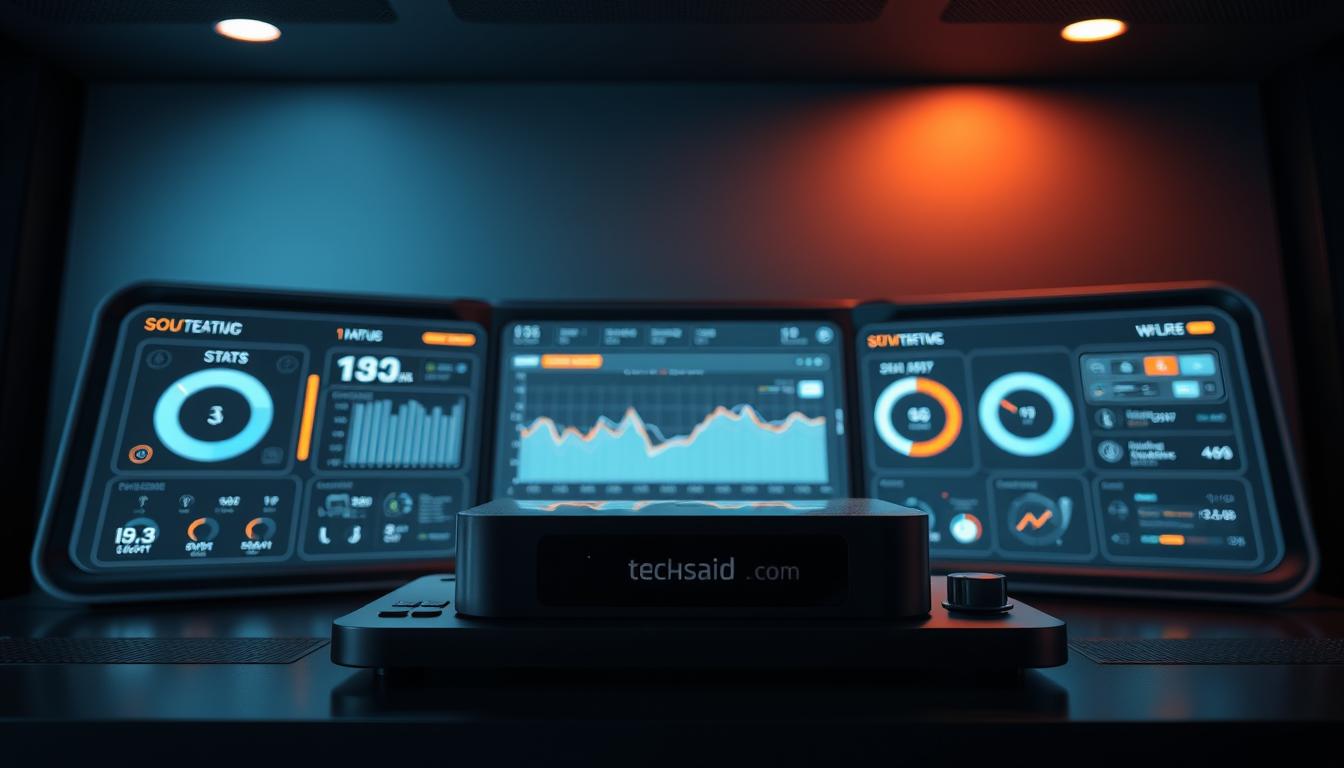The number of connected devices is growing fast. This makes effective IoT device management very important. We use these devices for many things, like in factories and in our homes. So, we need to manage them well.

Managing connected devices means taking care of their security and being able to control them from afar. It's key for both businesses and people. In this guide, we'll look at the main parts of managing connected devices. We'll also share important tips for doing it right.
Understanding IoT Device Management
The Internet of Things (IoT) is growing fast. Knowing how to manage IoT devices is key. It involves watching, controlling, and keeping devices safe. Good internet of things device control helps companies work better, save money, and be more efficient.

IoT device monitoring is vital. It lets businesses see how devices are doing, spot problems early, and make smart choices. With the right tools, companies can keep their IoT devices running well and safely.
IoT device management gives real-time info on how devices are doing. This helps fix issues before they cause trouble. It makes businesses run smoother and keeps customers happy.
The Growing Importance of IoT Device Management
IoT is growing fast, and managing devices well is key. With more devices and complex systems, we need strong smart device management solutions.
As IoT grows, we need better ways to set up and manage devices. This ensures they work well, stay secure, and are reliable. Companies want to manage their IoT devices from start to finish.

- The rising number of connected devices
- Increasing complexity of IoT ecosystems
- Need for secure and efficient device configuration
- Growing demand for real-time monitoring and control
Using a top-notch smart device management solution helps companies tackle these issues. It lets them use their IoT to its fullest. This boosts work efficiency, customer happiness, and innovation.
Core IoT Device Management Functionalities
The heart of a good IoT setup is its core management tools. These tools help companies safely add IoT devices to their networks. They also manage who can access these devices.
Registration and Authentication Processes
Registration and authentication processes are key in IoT management. They make sure only approved devices join the network. This boosts iot device security management.
When a device signs up, it joins the management system. Then, it proves its identity before getting network access.
Identity Management Systems
Identity management systems are crucial for IoT devices. They give each device its own identity, track its actions, and control its network access. This strengthens iot device security management and lowers the chance of unauthorized access.
Good identity management systems also let companies watch device behavior. They can spot oddities and tackle security threats. By linking registration and authentication with identity management, companies can keep their IoT devices safe and running smoothly.

By grasping and using these core IoT management tools, companies can manage their IoT better. This leads to better security and efficiency.
IoT Device Security Management
IoT devices are becoming more common, making strong security management key. It's important to protect these devices from cyber threats.
Certificate Management
Certificate management is crucial for IoT security. It deals with issuing, managing, and renewing digital certificates. This ensures safe communication between devices and the network.
Good certificate management stops unauthorized access. It also keeps data exchanged between IoT devices and the cloud safe.
Role-Based Access Control
Role-Based Access Control (RBAC) is also vital for IoT security. RBAC limits access to sensitive data and functions based on a user's role. This helps prevent damage from insider threats or compromised accounts.
In summary, managing IoT device security involves certificate management and RBAC. These measures help reduce risks and protect sensitive data.
Remote Device Management Capabilities
Remote device management is key for keeping IoT systems safe and running smoothly. It's a big help for companies with lots of IoT devices spread out. They can manage them well without having to visit each one.
Update scheduling and prioritization are big parts of remote device management. It's about planning when to update devices so it doesn't mess with their work. Updates are done when it's least busy, keeping devices safe and up-to-date.
Update Scheduling and Prioritization
Update scheduling lets companies pick the best times for updates. This way, it doesn't slow down work too much. Prioritizing updates means fixing the most important problems first, keeping devices safe.
Rollback Mechanisms
When updates don't work out, rollback mechanisms help. They let companies go back to the old version, keeping things running smoothly. This is very important for keeping IoT systems reliable.
Using remote device management helps make IoT systems better. It saves money and makes them work more efficiently. This is good for any IoT strategy.
Centralized Device Management Solutions
Managing IoT devices is easier than ever with centralized device management solutions. These tools offer a single place to manage all IoT devices. This makes it easier to see and control everything.
A big part of this is the dashboard design and usability. A good dashboard lets admins check device status, do diagnostics, and manage tasks easily. A well-made dashboard helps users learn faster and work more efficiently.
Dashboard Design and Usability
A dashboard's value comes from how it shows complex data simply and clearly. Customizable widgets and real-time data are key. They help admins spot problems fast and make smart choices.
Alert Management Systems
Alert management systems are vital for managing devices. They alert admins to issues early, so they can fix them before they get worse. Good alert systems set the right alerts and make sure they're useful.
Using a centralized device management solution with a great dashboard and alert system makes managing IoT devices simpler. It boosts work efficiency and makes IoT systems more reliable.
Device Connectivity Control and Management
Device connectivity control and management are key to IoT ecosystems. They make sure devices work well and talk to each other smoothly.
MQTT, CoAP, and Other IoT Protocols
IoT devices use different ways to talk to each other. MQTT (Message Queuing Telemetry Transport) is light and great for IoT. CoAP (Constrained Application Protocol) works well in tight spaces and is easy to use.
Other important protocols include HTTP and LWM2M (Lightweight Machine-to-Machine). The right protocol depends on what the IoT device needs. This includes how it works, the network it's on, and how much data it needs.
Cellular, Wi-Fi, and LPWAN Connectivity
IoT devices can connect in many ways. Cellular networks cover a lot of ground and are good for moving devices. Wi-Fi is great for local use, offering fast data. LPWAN (Low Power Wide Area Network) is perfect for devices that need to last a long time on battery.
Picking the best way for devices to connect is vital for IoT success. Knowing the options helps make sure devices stay connected and work as planned.
Smart Device Management Solutions
In the era of IoT, smart device management solutions offer a proactive approach to managing devices. These solutions are designed to help organizations manage their IoT devices more effectively. They anticipate and prevent potential issues.
Predictive Maintenance Capabilities
One of the key features of smart device management solutions is their predictive maintenance capabilities. They use data analytics and machine learning algorithms. This helps predict when devices are likely to fail or need maintenance.
This enables organizations to take proactive measures. It reduces downtime and improves overall device reliability.
Another critical aspect of smart device management solutions is their anomaly detection systems. These systems monitor device behavior in real-time. They identify unusual patterns or activities that could indicate a security threat or device malfunction.
By detecting anomalies early, organizations can respond quickly. This helps prevent or mitigate potential issues.
The combination of predictive maintenance and anomaly detection within smart device management solutions empowers organizations. It helps them manage their IoT devices more efficiently. By adopting these advanced capabilities, businesses can enhance device reliability, reduce operational costs, and improve their overall IoT ecosystem.
Data Management and Analytics in IoT Ecosystems
IoT ecosystems create a lot of data. This makes data management and analytics very important for companies.
The amount and speed of IoT data need advanced analytics. Time-series data analysis is key. It helps spot trends and patterns over time. This is vital for predictive maintenance and improving IoT device performance.
Time-Series Data Analysis
Time-series data analysis looks at data collected at set times. It helps find patterns and trends for business decisions. For example, analyzing temperature sensor data can predict when maintenance is needed. This reduces downtime and boosts efficiency.
Using IoT data with business intelligence (BI) tools gives a deeper understanding of operations. Combining IoT data with other business data reveals new insights. For instance, mixing IoT data with customer info helps tailor services to meet customer needs better.
Good data management and analytics in IoT ecosystems need a strong infrastructure and advanced analytics. By using these tools, companies can fully use their IoT data. This drives business growth and innovation.
Industry-Specific IoT Device Management Approaches
Managing IoT devices is key for different sectors. Each industry has its own needs and challenges. This depends on their operations, the devices they use, and the data they handle.
In healthcare, managing IoT devices is about keeping patient data safe. Medical devices like insulin pumps and pacemakers are online, making them a cyber threat risk. To keep them safe, healthcare needs strong security, like encryption and updates.
The manufacturing industry uses IoT to improve production. Industrial IoT devices check equipment, predict when it needs fixing, and make production smoother. Here, IoT management means keeping devices connected, data correct, and monitoring in real-time.
In transportation, IoT is vital for managing fleets and logistics. Devices like GPS and telematics systems track vehicles in real-time. Good management means reliable data, secure devices, and working with logistics systems.
Knowing their industry's needs helps companies create custom IoT management plans. These plans boost efficiency, security, and innovation.
Conclusion: The Future of IoT Device Management
The future of IoT device management is changing fast. New technologies and innovations are leading the way. As more companies use IoT, managing these devices will become even more crucial.
Edge computing, artificial intelligence, and 5G networks will change the IoT world. They will open up new possibilities and uses. This means businesses can explore new ways to use IoT.
Organizations need to focus on IoT device management. They should pay attention to security, remote management, and data analysis. By understanding these trends, companies can use IoT to grow and innovate.
As the IoT world gets bigger, managing devices will become even more important. Businesses must be ready to handle this challenge. This will help them stay ahead in the fast-changing IoT landscape.











1 Comments
you can poste more artical
ReplyDelete